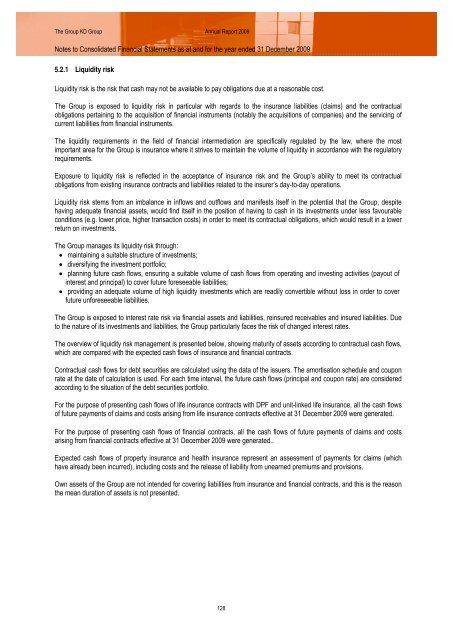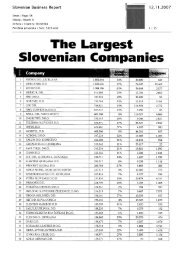The Group KD Group and KD Group dd
The Group KD Group and KD Group dd
The Group KD Group and KD Group dd
You also want an ePaper? Increase the reach of your titles
YUMPU automatically turns print PDFs into web optimized ePapers that Google loves.
<strong>The</strong> <strong>Group</strong> <strong>KD</strong> <strong>Group</strong> Annual Report 2009<br />
Notes to Consolidated Financial Statements as at <strong>and</strong> for the year ended 31 December 2009<br />
5.2.1 Liquidity risk<br />
Liquidity risk is the risk that cash may not be available to pay obligations due at a reasonable cost.<br />
<strong>The</strong> <strong>Group</strong> is exposed to liquidity risk in particular with regards to the insurance liabilities (claims) <strong>and</strong> the contractual<br />
obligations pertaining to the acquisition of financial instruments (notably the acquisitions of companies) <strong>and</strong> the servicing of<br />
current liabilities from financial instruments.<br />
<strong>The</strong> liquidity requirements in the field of financial intermediation are specifically regulated by the law, where the most<br />
important area for the <strong>Group</strong> is insurance where it strives to maintain the volume of liquidity in accordance with the regulatory<br />
requirements.<br />
Exposure to liquidity risk is reflected in the acceptance of insurance risk <strong>and</strong> the <strong>Group</strong>’s ability to meet its contractual<br />
obligations from existing insurance contracts <strong>and</strong> liabilities related to the insurer’s day-to-day operations.<br />
Liquidity risk stems from an imbalance in inflows <strong>and</strong> outflows <strong>and</strong> manifests itself in the potential that the <strong>Group</strong>, despite<br />
having adequate financial assets, would find itself in the position of having to cash in its investments under less favourable<br />
conditions (e.g. lower price, higher transaction costs) in order to meet its contractual obligations, which would result in a lower<br />
return on investments.<br />
<strong>The</strong> <strong>Group</strong> manages its liquidity risk through:<br />
• maintaining a suitable structure of investments;<br />
• diversifying the investment portfolio;<br />
• planning future cash flows, ensuring a suitable volume of cash flows from operating <strong>and</strong> investing activities (payout of<br />
interest <strong>and</strong> principal) to cover future foreseeable liabilities;<br />
• providing an adequate volume of high liquidity investments which are readily convertible without loss in order to cover<br />
future unforeseeable liabilities.<br />
<strong>The</strong> <strong>Group</strong> is exposed to interest rate risk via financial assets <strong>and</strong> liabilities, reinsured receivables <strong>and</strong> insured liabilities. Due<br />
to the nature of its investments <strong>and</strong> liabilities, the <strong>Group</strong> particularly faces the risk of changed interest rates.<br />
<strong>The</strong> overview of liquidity risk management is presented below, showing maturity of assets according to contractual cash flows,<br />
which are compared with the expected cash flows of insurance <strong>and</strong> financial contracts.<br />
Contractual cash flows for debt securities are calculated using the data of the issuers. <strong>The</strong> amortisation schedule <strong>and</strong> coupon<br />
rate at the date of calculation is used. For each time interval, the future cash flows (principal <strong>and</strong> coupon rate) are considered<br />
according to the situation of the debt securities portfolio.<br />
For the purpose of presenting cash flows of life insurance contracts with DPF <strong>and</strong> unit-linked life insurance, all the cash flows<br />
of future payments of claims <strong>and</strong> costs arising from life insurance contracts effective at 31 December 2009 were generated.<br />
For the purpose of presenting cash flows of financial contracts, all the cash flows of future payments of claims <strong>and</strong> costs<br />
arising from financial contracts effective at 31 December 2009 were generated..<br />
Expected cash flows of property insurance <strong>and</strong> health insurance represent an assessment of payments for claims (which<br />
have already been incurred), including costs <strong>and</strong> the release of liability from unearned premiums <strong>and</strong> provisions.<br />
Own assets of the <strong>Group</strong> are not intended for covering liabilities from insurance <strong>and</strong> financial contracts, <strong>and</strong> this is the reason<br />
the mean duration of assets is not presented.<br />
128







